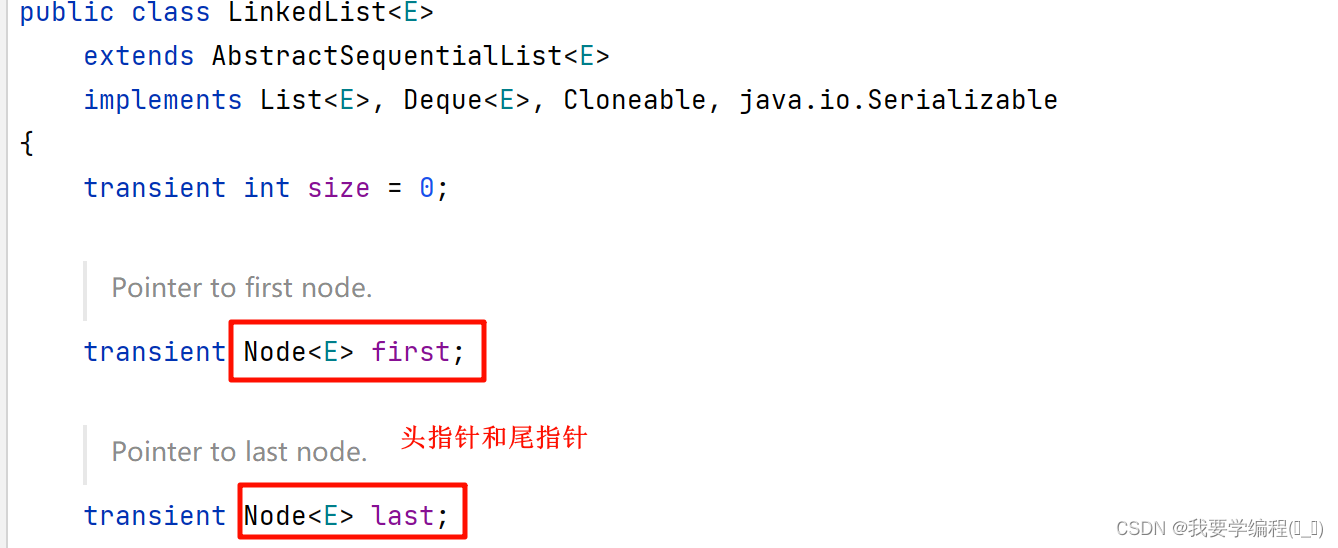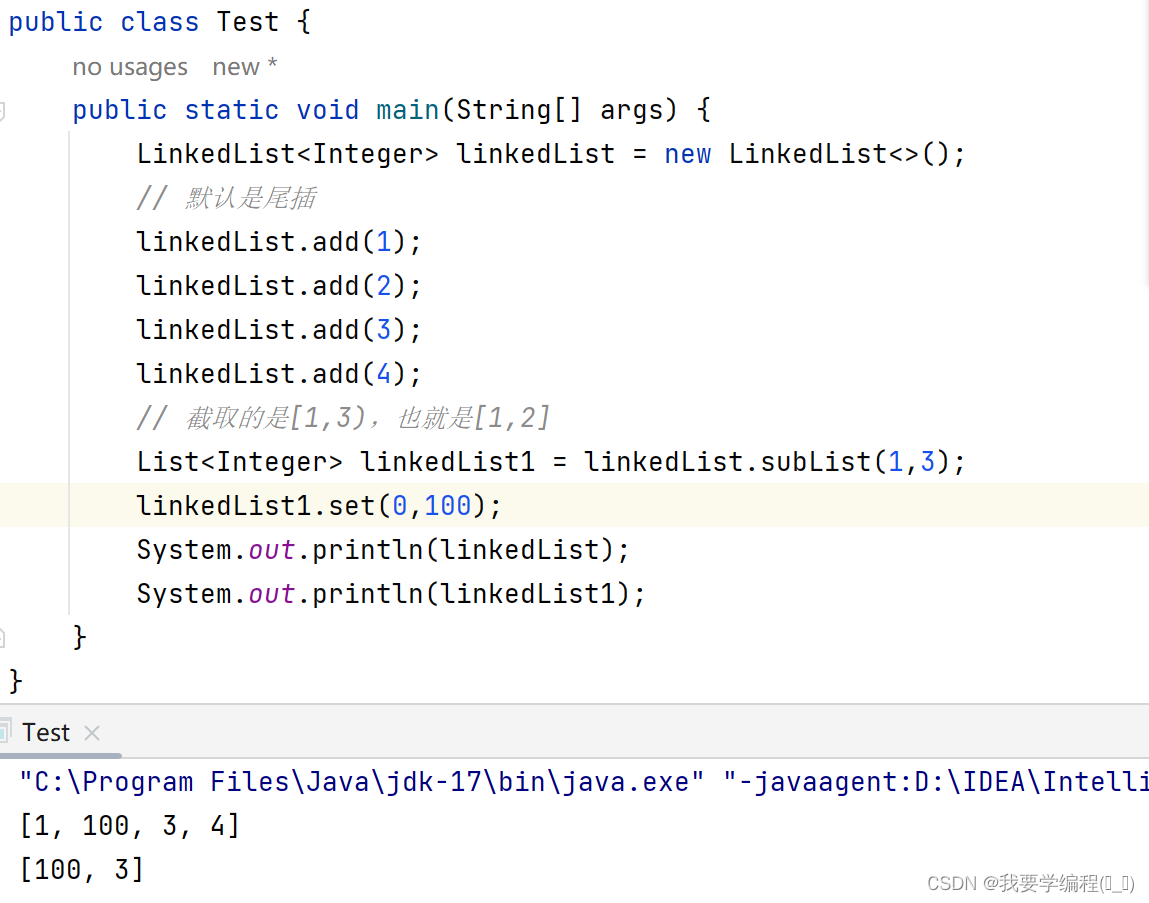手动实现单链表的源码
下面是Java版的链表源码:
// 无头单向非循环链表实现
public class SingleLinkedList {
// 链表是有一个一个的节点组成,因此得先创建节点
// 链表的节点由两部分组成:数值域与地址域
// 既然有多个部分,那么就可以写在类中
// 又因为节点是在单链表中(单链表中包含一个又一个的节点)
// 因此节点就可以成为单链表的内部类
// 静态内部类可以只通过类名来访问,方便
public static class listNode {
public int val; // 存放数值
// 是一个引用指向下一个节点的地址
public listNode next; // 指向下一个节点的地址
public listNode(int val) {
// 新创建的节点的next应该为null,因为next为字段。因此其默认值为null,无需修改
this.val = val;
}
}
public listNode head; // 头节点
// 头插法
public void addFirst(int data){
listNode newNode = new listNode(data);
// 先判断这个链表是否有节点
if (head == null) {
//那么新增的这个节点就是头节点
head = newNode;
}else {
// 把新节点的next指向head,并且把head指向新节点
newNode.next = head;
head = newNode;
}
}
// 尾插法
public void addLast(int data){
listNode newNode = new listNode(data);
// 先判断这个链表是否为空
if (head == null) {
head = newNode;
}else {
listNode cur = head;
// 找到尾节点
while (cur.next != null) {
cur = cur.next;
}
// 将尾节点的next指向新节点,就完成了尾插
cur.next = newNode;
}
}
// 任意位置插入,第一个数据节点为0号下标
public boolean addIndex(int index,int data) throws AddIndexofException{
// 先判断插入的位置是否合法
if (index < 0 || index > size()) {
throw new AddIndexofException("addIndex() index位置异常");
}
// 先判断这个链表是否为空,如果是空,既可以采取尾插,也可以采取头插
if (head == null) {
addLast(data);
}else if (index == 0) {
addFirst(data);
}else {
listNode newNode = new listNode(data);
// 找到pos-1的位置
listNode cur = head;
while (index-1 > 0) {
cur = cur.next;
index--;
}
// 两个的顺序不能变
newNode.next = cur.next;
cur.next = newNode;
return true;
}
return false;
}
// 查找是否包含关键字key是否在单链表当中
public boolean contains(int key){
// 先判断链表是否为空
if (head == null) {
return false;
}
listNode cur = head;
while (cur != null) {
if (cur.val == key) {
return true;
}
cur = cur.next;
}
return false;
}
// 删除第一次出现关键字为key的节点
public void remove(int key) throws SingleLinkedisEmptyException, NotFindException{
// 判断链表是否为空
if (head == null) {
throw new SingleLinkedisEmptyException("单链表为空异常");
} else if (head.next == null) {
// 如果链表中只有一个元素的话,直接删除就行
if (head.val == key) {
head = null;
return;
}
else {
throw new NotFindException("找不到要删除的数异常");
}
} else if (head.val == key) {
// 头删
head = head.next;
return;
} else {
listNode cur = head;
while (cur.next != null) {
if (cur.next.val == key) {
// 开始删除
listNode del = cur.next.next;
cur.next = cur.next.next;
// 可能这里会有疑惑被删除的节点的next不是还指向了其后一个位置吗?
// 这样会不会有问题呢?当一个对象每人引用时,就会被标记回收
// 当然手动置为null,也是可以的
del = null;
return;
}
cur = cur.next;
}
}
throw new NotFindException("找不到要删除的数异常");
}
// 删除所有值为key的节点
public void removeAllKey(int key){
boolean flag = true;
// 判断链表是否为空
if (head == null) {
throw new SingleLinkedisEmptyException("单链表为空异常");
} else if (head.next == null) {
// 如果链表中只有一个元素的话,直接删除就行
if (head.val == key) {
head = null;
return;
}else {
throw new NotFindException("没有找到要删除的数据!");
}
} else if (head.val == key) {
// 如果头节点的值key,那就循环删除直至头节点的不为key
while (head.val == key) {
// 如果删除的只剩下最后一个节点了,就删除返回就行
if (head.next == null) {
head = head.next;
return;
}
}
flag = false;
} else {
listNode cur = head;
while (cur.next != null) {
if (cur.next.val == key) {
// 开始删除
listNode del = cur.next.next;
cur.next = cur.next.next;
// 可能这里会有疑惑被删除的节点的next不是还指向了其后一个位置吗?
// 这样会不会有问题呢?当一个对象每人引用时,就会被标记回收
// 当然手动置为null,也是可以的
del = null;
flag = false;
}else {
// 可能会出现连续的数字的情况
// 因此删除之后,还得判断这个cur之后的元素是否为key
cur = cur.next;
}
}
}
if (flag) {
throw new NotFindException("找不到要删除的数异常");
}
}
// 得到单链表的长度
public int size(){
// 先判断这个链表是否为空
if (head == null) {
return 0;
}
listNode cur = head;
int count = 0;
while (cur != null) {
count++;
cur = cur.next;
}
return count;
}
// 打印链表
public void display(){
listNode cur = head;
while (cur != null) {
System.out.print(cur.val+" ");
cur = cur.next;
}
System.out.println();
}
// 清空链表
public void clear(){
// 暴力解法:把head置为null,那么就没有引用指向这个头节点了
// 那么这个头节点就会被垃圾回收器给回收掉
// head = null;
// 上面那种方式可能会出现不安全的情况,因此采用遍历的形式
listNode cur = head;
while (cur != null) {
// cur.val = null;
listNode curNext = cur.next;
cur.next = null;
cur = curNext;
}
head = null;
}
}
AddlndexofException异常:
public class AddIndexofException extends RuntimeException{
public AddIndexofException() {
super();
}
public AddIndexofException(String msg) {
super(msg);
}
}
NotFindException异常:
public class NotFindException extends RuntimeException{
public NotFindException() {
super();
}
public NotFindException(String msg) {
super(msg);
}
}SingleLinkedisEmptyException异常:
public class SingleLinkedisEmptyException extends RuntimeException{
public SingleLinkedisEmptyException() {
super();
}
public SingleLinkedisEmptyException(String msg) {
super(msg);
}
}
这里来说明一下:为什么节点的引用是节点类型?
首先,我们最开始在学习引用的时候,说过引用其实就是一个变量类型,用来存放地址。而在C语言中是用指针来存放地址,按照C语言的说法,节点的地址就得用节点类型的指针来接收。那么listNode 类型的 next,就得用 listNode 来接收(引用)。就好像,在 new 应该对象时,这个对象的地址会给到一个引用变量,而这个引用变量的类型就是 new 关键字后面的。例如:Person person = new Person(); 。
双链表的学习,点我
上面这篇博文是关于链表的基础知识、链表的分类以及单链表的实现。都详细的进行了说明。
手动实现双链表的源码
public class MyLinkedList implements LinkedList {
//创建一个节点内部类
static class ListNode {
int val;
ListNode prev;
ListNode next;
public ListNode(int val) {
this.val = val;
}
}
public ListNode head;
public ListNode last;
// 头插
@Override
public void addFirst(int data) {
// 创建一个新的节点
ListNode newNode = new ListNode(data);
// 先判断链表是否为空
if (head == null) {
head = newNode;
last = newNode;
}else {
newNode.next = head;
head.prev = newNode;
head = newNode;
}
}
@Override
public void addLast(int data) {
// 创建一个新的节点
ListNode newNode = new ListNode(data);
// 先判断链表是否为空
if (head == null) {
head = newNode;
last = newNode;
}else {
last.next = newNode;
newNode.prev = last;
last = newNode;
}
}
@Override
public void addIndex(int data, int index) throws addIndexOfException {
// 判断这个index是否合法
if (index < 0 || index > size()) {
// 抛异常
throw new addIndexOfException("下标位置不合法异常!");
}
if (index == 0) {
// 头插
addFirst(data);
} else if (index == size()) {
// 尾插
addLast(data);
} else {
// 创建一个新的节点
ListNode newNode = new ListNode(data);
ListNode cur = head;
// 找到要插入的前一个位置
while (index-1 > 0) {
cur = cur.next;
index--;
}
ListNode curNext = cur.next;
cur.next = newNode;
newNode.next = curNext;
newNode.prev = cur;
curNext.prev = newNode;
}
}
@Override
public boolean contains(int key) {
ListNode cur = head;
while (cur != null) {
if (cur.val == key) {
return true;
}
cur = cur.next;
}
return false;
}
@Override
public void remove(int key) {
if (head == null) {
// 链表为空,就抛异常
throw new LinkedListIsEmptyException("链表为空异常!");
}else if (head.next == null) {
// 链表里面只有一个元素
if (head.val == key) {
head = null;
last = null;
return;
}else {
throw new NotFindException("找不到要删除的数异常!");
}
}else {
// 头删
if (head.val == key) {
head = head.next;
return;
} else if (last.val == key) {
// 尾删
last = last.prev;
last.next = null;
return;
}
ListNode cur = head;
while (cur != null) {
if (cur.val == key) {
// 开始删除
ListNode curNext = cur.next;
cur.prev.next = curNext;
curNext.prev = cur.prev;
return;
}
cur = cur.next;
}
throw new NotFindException("找不到要删除的数异常!");
}
}
@Override
public void removeAllkey(int key) {
if (head == null) {
// 链表为空,就抛异常
throw new LinkedListIsEmptyException("链表为空异常!");
}else if (head.next == null) {
// 链表里面只有一个元素
if (head.val == key) {
head = null;
last = null;
return;
}else {
throw new NotFindException("找不到要删除的数异常!");
}
}else {
boolean flag = false;
// 头删
while (head.val == key) {
flag = true;
head = head.next;
if (head == null) {
return;
}
}
while (last.val == key) {
// 尾删
flag = true;
last = last.prev;
last.next = null;
}
ListNode cur = head;
while (cur != null) {
if (cur.val == key) {
// 开始删除
flag = true;
ListNode curNext = cur.next;
cur.prev.next = curNext;
curNext.prev = cur.prev;
}
cur = cur.next;
}
if (!flag) {
throw new NotFindException("找不到要删除的数异常!");
}
}
}
@Override
public int size() {
ListNode cur = head;
int count = 0;
while (cur != null) {
count++;
cur = cur.next;
}
return count;
}
@Override
public void clear() {
// 暴力做法
// head = last = null;
// 温柔做法
ListNode cur = head;
while (cur != null) {
// cur.val = null;
cur.prev = null;
ListNode curNext = cur.next;
cur.next = null;
cur = curNext;
}
head = last = null;
}
@Override
public void display() {
ListNode cur = head;
while (cur != null) {
System.out.print(cur.val+" ");
cur = cur.next;
}
System.out.println();
}
}addlndexOfException异常:
public class addIndexOfException extends RuntimeException {
public addIndexOfException(String msg) {
super(msg);
}
public addIndexOfException() {
super();
}
}
LinkedListlsEmptyException异常:
public class LinkedListIsEmptyException extends RuntimeException {
public LinkedListIsEmptyException(String msg) {
super(msg);
}
public LinkedListIsEmptyException() {
super();
}
}
NotFindException异常:
public class NotFindException extends RuntimeException {
public NotFindException(String msg) {
super(msg);
}
public NotFindException() {
super();
}
}
单链表和双链表在代码上,总体来说,大差不差。
分析 LinkedList 的源码
LinkedList的底层使用了双向链表

LinkedList的使用
构造方法与 ArrayList 差不多,只有一个无参的和一个带参数的。带参的类型是实现了Collection接口就行。
常用方法
| 方法 | 说明 |
| boolean add(E e) | 尾插 e |
| void add(int index, E element) | 将 e 插入到 index 位置 |
| boolean addAll(Collection<? extends E> c) | 尾插 c 中的所有元素 |
| E remove(int index) | 删除 index位置元素 |
| boolean remove(Object o) | 删除遇到的第一个o |
| E get(int index) | 获取下标index 位置元素 |
| E set(int index, E element) | 将下标index位置元素设置为 element |
| void clear() | 清空 |
| boolean contains(Object o) | 判断o是否在链表中 |
| int indexOf(Object o) | 返回第一个o所在下标 |
| int lastlndexOf(Object o) | 返回最后一个o的下标 |
| List<E> subList(int fromlndex, int tolndex) | 截取部分list |

同样这里 subList 的截取不会产生新的对象。
其遍历方式和 ArrayList 是一样的。
ArrayList和LinkedList的区别
| 区别 | ArrayList | LinkedList |
| 存储空间上 | 物理上一定连续 | 逻辑上连续,但物理上不一定连续 |
| 随机访问 | 支持0(1) | 不支持:O(N) |
| 头插 | 需要搬移元素,效率低O(N) | 只需修改引用的指向,时间复杂度为O(1) |
| 插入 | 空间不够时需要扩容 | 没有容量的概念 |
| 应用场景 | 元素高效存储+频繁访问 | 任意位置插入和删除频繁 |
好啦!本期 数据结构之LinkedList与链表(上)的学习之旅就到此结束啦!我们下一期再一起学习吧!

